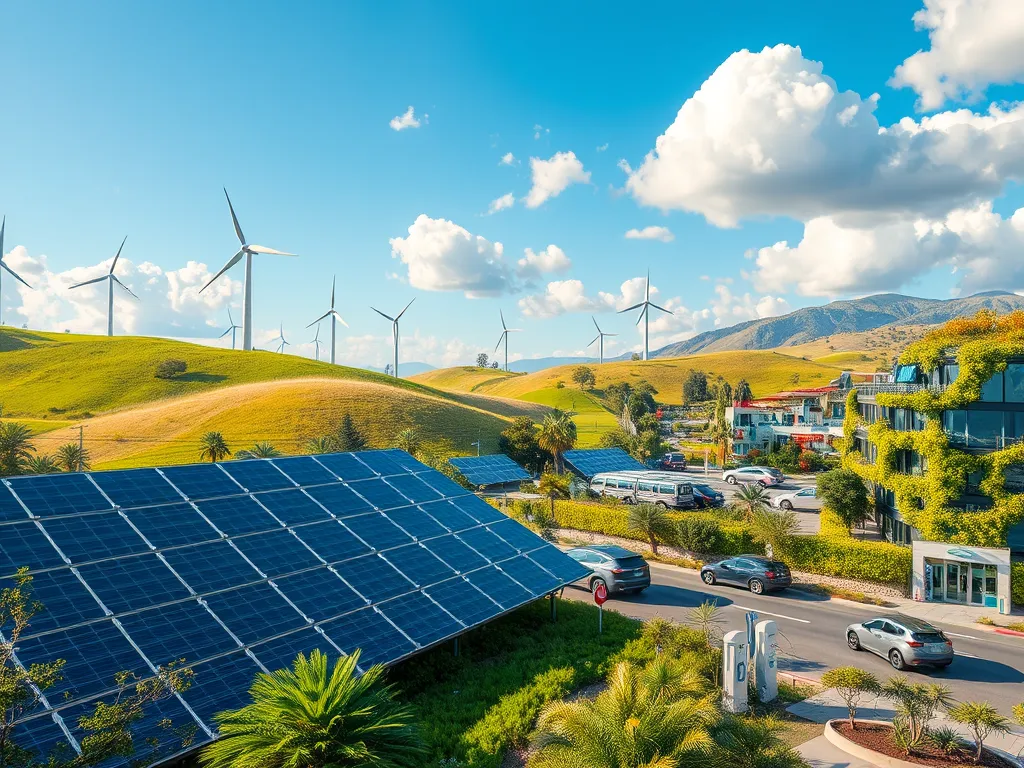Explore California's Bold Clean Energy Initiatives Today

California Clean Energy Initiatives: Paving the Way for a Sustainable Future
California has emerged as a global leader in clean energy initiatives, setting ambitious goals to combat climate change and promote sustainability. The California Clean Energy Initiatives focus on reducing greenhouse gas emissions while transitioning to renewable energy sources. These initiatives encompass various strategies including energy efficiency improvements, government policies, and community engagement efforts, all aimed at creating a greener and more sustainable California.
The significance of California Clean Energy Initiatives cannot be understated. With a commitment to achieving 100% clean electricity by 2045, California is fostering innovation in renewable resources such as solar, wind, and hydropower. The initiatives have garnered national attention and inspire other states to adopt similar measures, showcasing that a transition to clean energy is not only necessary but also feasible and beneficial for the economy and environment.
The ambitious goals set by the state are heavily influenced by progressive policies under the California Clean Energy Initiatives, aiming for a sustainable future.
In addition to renewable energy expansion, the California Clean Energy Initiatives encompass energy efficiency programs designed to reduce energy consumption. These programs not only help residents save money on utility bills but also contribute to greenhouse gas reduction targets. The state's multifaceted approach strengthens its position as a leader in clean energy and sets a precedent for future legislation in other regions.
As California continues to lead the way in clean energy, there is a growing emphasis on the importance of community engagement and public awareness in achieving these initiatives. The participation of local communities in clean energy projects contributes significantly to the state’s overall success in reducing emissions and promoting sustainable living practices across the population.
Ultimately, the California Clean Energy Initiatives serve as a model for global clean energy transitions. By aligning technological innovations with strategic policies and community involvement, California embarks on addressing climate change and environmental challenges in an holistic manner, paving the way for a more sustainable future.
Renewable Energy Sources: The Backbone of California's Clean Energy Initiatives
California's commitment to renewable energy sources is evident through its extensive solar energy expansion. The state possesses one of the largest solar power markets in the world, with numerous large-scale solar farms and residential rooftop installations generating clean electricity across the region. This focus on solar energy significantly reduces reliance on fossil fuels and lowers greenhouse gas emissions, aligning with California's long-term sustainability goals.
Wind power also contributes to the California Clean Energy Initiatives, with various wind farms strategically located across the state. California boasts a robust wind energy capacity, often ranking among the top states in wind energy production. Increasing investments in wind power are essential for achieving clean energy targets and diversifying the energy mix, fostering resilience in the overall energy system.
Hydropower innovations present another key component of the state's renewable energy portfolio. California's extensive network of reservoirs and rivers supports hydropower generation, providing a reliable and efficient energy source. Recent advancements include improvements in turbine technology and environmental management practices that aim to balance energy production with ecological conservation.
Biomass and biofuels development are additional facets of California's renewable energy strategy. By utilizing organic waste materials for energy generation, California promotes sustainability while addressing waste management challenges. This innovative approach not only contributes to reducing emissions but also supports the state’s economy by creating jobs in the green technology sector.
Energy Efficiency Programs: Reducing Consumption and Emissions
California's energy efficiency programs are central to its Clean Energy Initiatives, aiming to achieve substantial energy savings across the state. Setting ambitious energy savings goals fosters a culture of efficiency that positively impacts both residential and commercial sectors, contributing to overall emissions reduction targets.
The implementation of innovative building codes is a cornerstone of California's energy efficiency efforts. These codes integrate sustainable design principles and mandate the use of energy-efficient materials and systems, reducing energy consumption in new construction and renovations, contributing to lower utility costs and enhanced environmental benefits.
Incentives for energy-efficient appliances further enhance California Clean Energy Initiatives. Programs offering rebates for energy-efficient products motivate households and businesses to upgrade aging appliances, resulting in significant long-term energy savings and a reduction in greenhouse gas emissions.
Community energy efficiency initiatives play a pivotal role in encouraging collective participation in conservation efforts. Local governments, in collaboration with state programs, run campaigns and workshops aimed at educating residents about energy-saving practices, fostering a culture of sustainability within communities across California.
Government Policies and Regulations: Supporting Clean Energy Transition
Legislation supporting clean energy initiatives is a driving force behind California’s ambitious climate goals. Laws mandating renewable energy procurement and promoting emissions reductions have transformed the energy landscape in the state, establishing a regulatory framework that prioritizes sustainability.
California's commitment to carbon neutrality by 2045 reflects its dedication to addressing climate change comprehensively. This goal involves rigorous strategies in emissions reduction across all sectors, demonstrating the state's leadership in implementing forward-thinking policies aimed at addressing pressing environmental challenges.
The regulatory framework established supports clean tech innovation, encouraging investment in sustainable technologies. Streamlined permitting processes and supportive policies create a conducive environment for clean tech development, positioning California as a hub for innovative solutions that address energy challenges.
Partnerships with the private sector further enhance the effectiveness of California's clean energy policies. Collaborative initiatives between the government and businesses lead to innovative projects and investments that accelerate the transition to a clean energy future, amplifying the impact of state-led initiatives.
Community Impact and Engagement: Empowering Citizens in Clean Energy
Grassroots movements have emerged as a powerful force in promoting clean energy initiatives within California's communities. Local organizations and advocacy groups mobilize residents to engage in sustainability efforts, providing vital support to state and local programs through community-driven campaigns that promote awareness and participation.
Local government involvement in clean energy initiatives amplifies the impact of state policies. City and county programs often align with broader state objectives, facilitating the implementation of clean energy solutions tailored to the specific needs of local communities and creating a more resilient energy future.
Public awareness campaigns play an essential role in fostering understanding and participation in the California Clean Energy Initiatives. Through targeted outreach and educational efforts, organizations can inform the public about sustainable practices and the benefits of transitioning to renewable energy, ultimately leading to a more environmentally-conscious populace.
Community solar projects provide opportunities for residents to access clean energy solutions even if they lack suitable infrastructure for individual solar installations. By creating shared solar programs, communities can collectively benefit from renewable energy production, reducing costs and furthering California's clean energy objectives.
Technology and Innovation in Clean Energy: Advancing the Future
Advancements in energy storage technologies are crucial for achieving the goals of California Clean Energy Initiatives. Improved battery technologies enable the effective storage of renewable energy, ensuring reliability and resilience in the energy supply. This shift not only enhances the integration of solar and wind energy but also supports grid stability.
The development of smart grids positions California at the forefront of energy innovation. By incorporating advanced communication technologies into the power infrastructure, smart grids enhance energy distribution efficiency, improve demand response capabilities, and enable better management of renewable energy resources.
Emerging clean tech startups are instrumental in driving California's clean energy future. These innovative companies develop cutting-edge solutions, from energy efficiency technologies to sustainable transportation, positioning California as a global leader in clean technology innovation.
The impact of AI on energy efficiency and management represents a significant advancement in clean energy initiatives. Integrating artificial intelligence in energy management systems allows for optimized energy consumption, predictive maintenance, and improved operational efficiency, further enhancing California's clean energy landscape.
Challenges and Opportunities in California's Clean Energy Transition
Barriers to clean energy adoption persist, posing challenges to fully realizing California's clean energy potential. Issues such as regulatory hurdles, funding limitations, and geographic discrepancies can hinder widespread access to clean energy, necessitating ongoing attention and action to overcome these obstacles.
The economic impacts of the transition to clean energy reveal both challenges and opportunities. While transitioning away from traditional energy sources can create temporary disruptions, the long-term benefits include job creation in renewable sectors, reduced energy costs, and decreased health impacts from pollution.
The public vs. private sector roles in clean energy initiatives must be carefully balanced to ensure effective implementation. Collaborative efforts between government agencies and private enterprises can lead to innovative solutions, with both sectors playing a vital role in driving California's clean energy agenda.
Overall, future opportunities in the clean energy sector are promising. As technology evolves and regulatory support continues, California can further solidify its position as a leader in the clean energy landscape, creating a sustainable, economically viable future for its residents.
